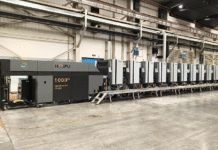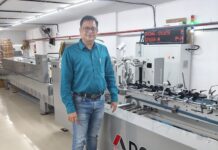A press release from Heidelberg dated 10 February 2021 states that due to the increasingly tangible successes yielded by the company’s transformation, plus growing demand from China and, since the third quarter, from Europe, Heidelberg is raising its target operating return for the financial year 2020/21 as a whole. Consequently, the company anticipates that its EBITDA margin excluding restructuring result will grow to approximately 7%, even though the coronavirus pandemic may lead to a sales decline of around € 450 million to € 500 million compared to the previous year (previous year’s sales: € 2,349 million) for the year as a whole.
Previously, Heidelberg had anticipated an EBITDA margin that would, at its lowest, equal that of the previous year at 4.3%. The company adds that there is an encouraging sign for the coming months that print volumes among its customers have almost reached the previous year’s levels, with the print volume in the packaging sector even exceeding the previous year’s level.
“The successful roll-out of the transformation measures has enabled Heidelberg to achieve a clearly positive operating result, despite the huge pressures caused by COVID-19. When it comes to both our finances and our balance sheet, we have done our homework. Signs of recovery are now emerging on the markets in China and Europe that are important to us. That is why our EBITDA target margin excluding restructuring result is being increased to around 7%. The growing interest in our contract business and strong demand for our electromobility charging stations are also grounds to be optimistic about the future,” says Heidelberg CEO Rainer Hundsdörfer, commenting on the developments.
In the third quarter, the company says the numerous measures of the transformation program launched in March of last year more than compensated for the negative effect on earnings caused by a significant drop in sales due to Covid-19. As a result, after nine months of the financial year 2020/21 (1 April to 31 December 2020), the operating result, including effects from the implemented measures, was above that of the same period of the previous year. In addition, the period under review saw a slightly positive net result after taxes and significantly reduced net financial debt.
Reduction of 1,600 employees worldwide by 2023
The press release is quite detailed on both the successes and some of the company’s transformation process’s setbacks. One of the most important statements to our view (editor IPP & PSA) is that the company will be reducing its human resources worldwide by 1,600 employees over the next three years. It cites the measure as “Cutting approximately 1,600 jobs worldwide by 2023 (just under 1,000 of which will be cut during this financial year), a move that has been agreed with employee representatives and is being implemented on a socially acceptable basis.”
Strategic milestones
In the year under review, Heidelberg reached several milestones in its strategy to safeguard the company’s future on a sustainable basis, including –
– Reorganizing the company pension scheme in Germany, which bolstered the result and shareholder’s equity with earnings of € 73 million.
– Focusing on its core activities and selling the Belgian subsidiary CERM and the Belgian production site for printing chemicals, which made possible a total gain on disposal of € 19 million.
– Discontinuing unprofitable product lines that previously had an adverse effect on the result amounting to approximately € 50 million a year.
– Repaying the corporate bond early, which will disburden the financial result by € 12 million a year.
– Cutting approximately 1,600 jobs worldwide by 2023 (just under 1,000 of which will be cut during this financial year), a move that has been agreed with employee representatives and is being implemented on a socially acceptable basis. With additional sustainable savings in material and staff costs, this downsizing leads to savings of more than € 170 million for the financial year 2022/23.
– Selling property in Wiesloch-Walldorf and the Print Media Academy in Heidelberg for a purchase price totaling more than € 60 million as part of a site and structural optimization strategy.
– Agreeing to a production joint venture with the Chinese company Masterwork Group, which is creating opportunities in Asia and offers much better cost-efficiency.
– Doubling the production capacity for Heidelberg Wallboxes – the charging stations for electric cars – by April 2021.
Gallus sale falls through
The sale of the Gallus Group, which did not go ahead at the end of January 2021 despite a valid purchase contract, is clouding the positive picture. However, this is not causing limitations concerning the results forecast for the current financial year. CFO Marcus A. Wassenberg explains, “All in all, we have made much faster and more successful progress with our company’s transformation than previously reported. We have raised more than € 450 million in liquidity, reduced debt by approximately € 260 million, moved away from loss-makers, and will reduce costs by more than € 170 million a year on a sustainable basis. We are therefore confident we will return to attractive profitability in the medium term.”
Figures for the first nine months of the financial year 2020/21 –
order levels looking better
Although the market environment is still challenging, there were further signs of recovery for Heidelberg during the third quarter. While the Chinese market had already reached almost pre-crisis levels, the business started to get back to normal levels in Europe, too. After nine months of 2020/21 (1 April 2020 to 31 December 2020), sales were at € 1,289 million and therefore still approximately 24% below the same period of the previous year (€ 1,690 million). At € 1,421 million, incoming orders were 25% below the previous year (€ 1,900 million). However, the shortfall was lower in the third quarter, at just 12%, and, in December, incoming orders were back above the previous year’s figure for the first time in this financial year. The order backlog rose by € 55 million compared with the previous quarter, reaching € 682 million.
In a year-on-year comparison, EBITDA excluding restructuring results increased from € 117 million to € 147 million, despite lower sales. On the one hand, the cost situation was improved by short-time working (which continued to drop in the quarter under review) and cost savings from the implemented transformation measures, which amounted to approximately € 60 million after three quarters. On the other hand, earnings of € 73 million from reorganizing the pension plans for employees in Germany as well as from the sale of the Belgian subsidiary CERM (approx. € 8 million) and the Belgian production site for printing chemicals (around € 11 million) also had a positive impact. In the third quarter, EBITDA excluding restructuring result was € 50 million, and the EBITDA margin excluding restructuring result was 10.4%. After nine months, EBIT excluding restructuring results was € 88 million and substantially higher than the previous year (€ 46 million). On the whole, expenses for transformation measures led to a restructuring result of € –38 million (previous year: € –8 million). After factoring in slightly higher financial expenses, Heidelberg achieved a slight net profit after taxes of € 3 million, having recorded a loss of € –10 million in the previous year.
Free cash flow in the third quarter positive at € 42 million
Due to the conversion of securities into cash and cash equivalents and inflows from the portfolio mentioned above measures and improvements in net working capital, free cash flow was improved in the period under review by € 63 million to € –10 million. A positive figure of € 42 million was achieved in the third quarter. Following the comprehensive debt relief measures, net financial debt is € 127 million and thus € 262 million below the comparable figure from the previous year. Against this backdrop, leverage (the ratio of net financial debt to EBITDA excluding restructuring result from the last four quarters) dropped to just 1.0 (previous year: 1.9). Despite the slightly positive net profit after taxes, the further significant reduction in actuarial interest rates for the valuation of pension obligations in Germany meant that the equity ratio as per IFRS dropped to 2.6%, which Heidelberg considers unsatisfactory. However, the parent company still has a solid equity ratio of around 26% in its financial statement prepared based on German commercial law.
Forecast raised for profitability in FY 2020/21 as a whole
Given the recent noticeable improvement in the order situation in many regions, increasing savings as part of the transformation program, and the income generated from asset management and accounting measures, Heidelberg is raising its forecast for the EBITDA margin excluding restructuring result for the financial year 2020/21 as a whole. Despite the anticipated Covid- 19 related declines in sales of around € 450 million to € 500 million compared with the previous year (€ 2,349 million), the Company now expects a significant improvement in the EBITDA margin excluding restructuring result to around 7%. Previously the Company had targeted an EBITDA margin excluding restructuring results of at least the same level as the previous year (4.3%). The outlook is being adjusted, although the Gallus Group’s planned sale will not be completed. In the financial year 2020 / 2021, Heidelberg expects a significantly improved, but once again negative, after-tax result against the previous year and a rise in leverage starting from a low level.
The 2020/21 nine-month report, image material, and further information about the company are available in the Investor Relations and Press Lounge of Heidelberger Druckmaschinen AG at www.heidelberg.com.












